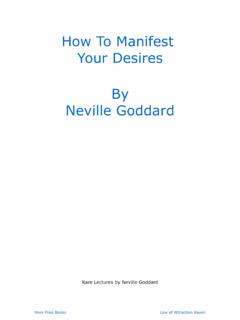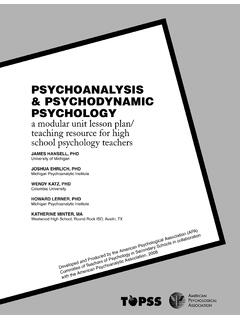Transcription of Kena Upanishad - Advaita Academy
1 Kena UpanishadWith explanation on Shankaracharya s commentaryK. Aravinda RaoAdvAitA AcAdemyKena UpanishadK. Aravinda RaoFirst Edition :July, 2014 Price : Rs: 50/- $ :Sai Likitha PrintersHyderabadPublished by : Advaita AcAdemyPlot no 852/ARoad No 44, Jubilee Hills,Hyderabad - 500033 Tel: +91 40 67354130 Dedicated toPujya SwamijiSri Tattvavidananda SaraswatiWith grateful regardsPublisher s NoteAdvaita Academy has been set up in the year 2009 to preserve and promote the wisdom of Advaita Vedanta with the following To reach out to spiritual seekers from around the world by providing access to - a) Live webcasts and recorded audio & video talks by teachers from different sampradaya-s. b) Articles & Blogs written by teachers and fellow seekers2. To offer online courses in Advaita Vedanta & Sanskrit3.
2 To establish traditional gurukulams offering long term courses in Advaita Vedanta. 4. To publish books on various texts Over the last three years, we have made progress in developing our website into a premier platform for content relating to Vedanta, with a collection of more than 1,500 videos. Our live-streaming initiative of classes by various teachers across the world has received tremendous support from spiritual seekers. Through this book on Kenopanishad by Sri K. Aravinda Raoji, we are now making foray into publication. It is indeed an honour for us that the first book to be published is by Sri K. Aravinda Rao, a Fellow Board Member and ardent supporter of all our initiatives. We are grateful to him for giving us this opportunity.
3 We are confident that his analysis and explanation on Shankaracharya s commentary would be of immense help to spiritual seekers. Hari Kiran Vadlamani Founder Advaita AcademyContentsPart - I 11-561. Peace Invocation 132. Introductory Commentary by Sri Shankaracharya 153. What Impels the Mind and Senses? 244. Brahman Consciousness is the Impelling Entity 285. Consciousness Cannot be Objectified 376. What You Worship is Not the Absolute 45 Part - II 57-857. On Claiming to Know Brahman 598. I Know Not and I Know Too 679. Knower Does Not Know 7010. Brahman is Revealed in All Cognitions 7311. Realization Here and Now 83 Part - III 87-10212. Vainglorious Gods 8913. Strange Manifestation 9414. Test for Gods 9515. Appearance of Uma The Goddess of Knowledge 101 Part - IV 103-12716.
4 The Teaching of the Goddess 10517. Contemplation at Divine Level 10918. Contemplation at the Level of Self 11219. Concluding Words of the Teacher 11620. Self-Discipline The Pedestal for Knowledge 121 IntroductionKena Upanishad is among the ten principal upanishads . It is one of the upanishads under the S maveda. With only thirty-five mantra-s it is tiny in size but very profound in its teaching. All major upanishads broadly discuss four aspects j va (the being), jagat (the universe), Brahman (the Supreme reality ) and s dhan (the means to attain Brahman). Kena, however, focuses merely on 1) the nature of Brahman, 2) to what extent the body mind complex is equipped to know it and 3) how to know Brahman. The human mind is highly limited, but with all its limitations, it is the only instrument that we have in order to contemplate on Brahman.
5 This Upanishad is in four parts. The first part poses the fundamental question that man has been asking since long. Are the senses and mind the final authority on knowing things or is there anything else which is behind them, enabling them to function? There is a more basic principle which is the ear of the ear, the mind of the mind and which enlivens all. This is called Brahman, but that Brahman cannot be known as an object of cognition. Whatever is objectified is, by definition, is inferior to the mind. The Upanishad makes radical statement that whatever the human mind has conceived in the form of god, in whatever religion it may be, is only a conception of mind and hence cannot be the absolute reality .
6 It is also ironical to note that though Brahman cannot be objectified, it can still be experienced. This is the assertion of all upanishads . This is validated by the experience of the seers. Part two attempts to explain the unexplainable through certain paradoxical statements characteristic of the upanishads . Brahman is not known to the person who claims or thinks that he knows It. It is known to the person who thinks that he does not know It. Brahman is said to be known to a person who can notice it as the very self of every cognition and the very light which illumines every cognition. Such a person distances himself from every cognitive experience and becomes a witness for all such cognitions which come and go.
7 He realizes his Self as the consciousness principle which is not distinct from the Brahman consciousness. In other words he has identified himself with Brahman. He has got over his limited perception of self and expanded his self to the level of Brahman. Such a person is said to be immortal, because consciousness is eternal. The Upanishad says that the mind is the very instrument to realize Brahman. The first two parts are meant for a sharp student. Of course, we have to keep in mind that it is not intellectual sharpness alone that makes a person eligible for pursuit of the knowledge of Brahman. The student or the seeker should have gone through the process of self-discipline through the well known methods of karma-yoga, up sana, practice of yoga and so on.
8 These are not specifically mentioned in the Upanishad , but these are essential prerequisites for deliberation on Brahman. Parts three and four address those who are not capable of such fine discriminative ability. The Upanishad comes down to their level and suggests the path of up sana, worship of a transactional level deity. This is otherwise called sagu a up sana, worship of a god with functions. We come across two words in Vedanta - sagu a and nirgu a levels of Brahman. What is conceived as god the omniscient, the omnipotent, judicious god who punishes the evil and protects the good is sagu a, the god with viiisome attributes. We have fashioned this god according to our own social needs, our own prejudices and our own understanding of ethics.
9 The nirgu a Brahman, on the other hand, refers to the pure existence-consciousness-infinitude which does not have any functions such as the cosmic super-cop that a sagu a god has. Hence, the last two parts suggest the sagu a path of worship as a stepping stone, or as a ladder to move on to the higher level of attributeless Brahman. This portion of the Upanishad tells an allegorical story. It seems that once gods had a victory over the demons but they thought that the victory was due to their might and not because of the power of Brahman behind them. It means that they had forgotten Brahman. The Supreme reality , out of compassion for them, manifested through its power of m y in order to demonstrate to them that their power was a manifestation of Brahman Itself.
10 Gods such as Agni, Vayu, and Indra become powerless in front of the manifestation. At this juncture, m y appears in the form of a goddess and explains to Indra about the nature of Brahman. Indra, thus becomes the first among gods to receive the knowledge of Brahman through the goddess Uma. The battle between gods and demons is the battle between good and evil in every person s mind. Thus, the moral of the above story is that one cannot find reality unless one has dissolved his ego, the notion of self. Even the gods failed in knowing Brahman because of their notion of ego. The Supreme reality had to teach them a lesson out of compassion. The final mantras of the Upanishad prescribe up sana of a sagu a deity in order to gradually achieve self-restraint and thus become eligible for the ultimate enlightenment.







